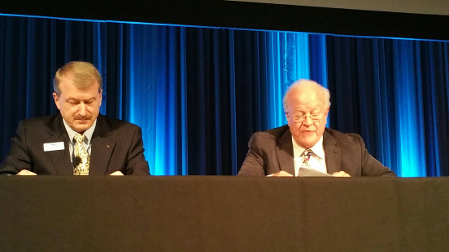SMPTE Keynote Explores the Past and Promising Future of Film and Television
With a shared presentation that guided the SMPTE audience through some of the most significant developments in film and television technology, Douglas Trumbull and Robert Seidel's opening keynote, "The Past, Present and Future of Broadcast and Cinema," offered perspective, a look at processes and archival video of many pivotal moments in imaging innovation.

As an example, filmmaker, innovator and entrepreneur Trumbull traced the development of multiple-screen projection from the final panoramic scene of Abel Gance's 1918 film “Napoleon” to Vitarama—an immersive WWII training system that allowed gunners to practice shooting (with light) footage of planes projected across five screens—to VistaVision to Cinerama to the emerging three-screen, panoramic Barco Escape format, to Trumbull's proprietary, portable 3D 4K "MAGI Pod" theatrical system.
Seidel, SMPTE President and Vice President of CBS Engineering and Advanced Technology, reviewed the evolution of television transmission from the work of early inventors John Logie Baird and Philo Farnsworth to the introduction of color TV and the NTSC standard to 1991's Hi-Vision experiments with CBS and NHK to trial HD broadcasts of the 1998 Nagano Olympics to the ongoing adoption of 4K television sets... all the way to CBS' current OTT experiments with its CBS app. (Seidel doesn't anticipate any threat with the proliferation of OTT content: "As long as we can capture and monetize [viewers], it's broadcasting.")
Each of the clips Seidel screened—for example, the HDTV broadcast of the Discovery Space Shuttle launch in 1998 (to a grand total of eight stations), an HD test of David Letterman's show, CEA (Consumer Electronics Association) president Gary Shapiro touting HD in 1998—seemed to resonate with the audience, who either remembered these moments or recognized the progress made since then or both. The footage certainly resonated with Seidel, who directed the design and installation of the CBS Broadcast Origination Center (and is seen in one of the videos excitedly testing equipment) and who headed up the engineering team that made broadcasting history when WRAL-HD, the CBS affiliate in Raleigh, N.C., became the first television station to transmit HDTV in 1996.
Both emphasized the importance of immersion and the challenges of offering the best possible audience experience. With a career that began producing a Cinerama film for the 1964 World's Fair ("Credit Cinerama with my interest in filmmaking," he said), Trumbull has maintained passion for researching—and creating, patenting and implementing—immersive theatrical experiences that has continued for more than 50 years.
Trumbull explained how the 48fps visuals for director Peter Jackson's “The Hobbit” films, perceived as "television-like" or "soap opera-like" impaired the audience's ability to immerse itself in the story, as may director Ang Lee's 120fps visuals in “Billy Lynn's Long Halftime Walk.” Trumbull compared the screening of these films to the involving "spectacular movie experience" of sweeping, epic 70mm films such as “Lawrence of Arabia”—something he is seeking to replicate with developing technologies. Considering how director Abel Gance wanted to immerse and impact “Napoleon” audiences in 1927 with a panoramic screen, Trumbull said, "We're in exactly the same situation at this moment."
Seidel and Trumbull are both intrigued by the potential of virtual, augmented and mixed reality, welcoming, as Trumbull said, "a new storytelling language."
Concluding the keynote, Seidel noted that "movies and television are alive and well," but that he continues to look forward to experiments with new and innovative technologies.
The professional video industry's #1 source for news, trends and product and tech information. Sign up below.
